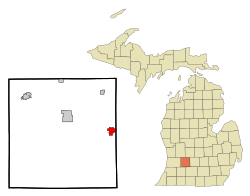Nashville, Michigan facts for kids
Quick facts for kids
Nashville, Michigan
|
|
|---|---|
|
Village
|
|

Location of Nashville, Michigan
|
|
| Country | United States |
| State | Michigan |
| County | Barry |
| Township | Castleton Township, Maple Grove Township |
| Area | |
| • Total | 2.22 sq mi (5.74 km2) |
| • Land | 2.11 sq mi (5.46 km2) |
| • Water | 0.11 sq mi (0.28 km2) |
| Elevation | 820 ft (250 m) |
| Population
(2020)
|
|
| • Total | 1,537 |
| • Density | 729.47/sq mi (281.61/km2) |
| Time zone | UTC-5 (Eastern (EST)) |
| • Summer (DST) | UTC-4 (EDT) |
| ZIP code |
49073
|
| Area code(s) | 517 |
| FIPS code | 26-56680 |
| GNIS feature ID | 0633223 |
| Website | http://www.nashvillemi.us/ |
Nashville is a small village located in Barry County, Michigan, in the United States. In 2020, about 1,537 people lived there. The village is mostly within Castleton Township. A small part of it also reaches into Maple Grove Township.
Contents
History of Nashville
Early Days and Land Ownership
The area where Nashville now stands was first bought by John R. Pettibone in 1836. This land was originally part of Barry Township. Later, it became part of Hastings Township. Finally, in 1842, it became Section 36 of the new Castleton Township.
By 1865, Robert B. Gregg owned the land. He planned out 127 building lots on the south side of the Thornapple River. Joshua Martin surveyed the land. Gregg sold his first lot to Enos Kuhlman. Over the next ten years, seven more sections were added to the original plan.
Mills and Industry
In 1852, Henry Feighner and his brother Solomon came to the area. They bought land and Henry also bought a sawmill. This sawmill was located on the west side of the Thornapple River. Solomon managed the sawmill for a while. Henry later sold the property to Phillip Holler around 1865.
In 1867, a new gristmill was built across the river from Holler's sawmill. A gristmill grinds grain into flour. Holler bought this new mill in 1868. He then used his original sawmill as a feedmill.
Later, around 1873 or 1874, a grain elevator was built. This was next to the new Grand River Valley Division of the Michigan Central Railroad. An elevator is a building used to store grain. In 1874, Ainsworth and Brooks bought the elevator. They added a steam-powered feedmill three years later. Holler also started a new way of making flour. His mill became known as the Nashville Roller Mills. By 1916, when Louis Lass and his son Otto bought the mill, they sold flour called Red-eye Flour.
How Nashville Got Its Name
Before 1869, the community did not have a name. In 1866, a chief engineer for the Grand River Valley Railroad was surveying a route. This route would go from Jackson to Grand Rapids. Garaudus Nash suggested that the community be named after him. Everyone agreed, and the community became Nashville. On March 26, 1869, Michigan's governor, Henry Baldwin, officially made Nashville an incorporated village.
Railroad Stop-Over
Starting in 1920, Nashville became an important stop for trains. It was the halfway point between the Jackson and Grand Rapids railroad stations. Trains would take one day to reach Nashville from either city. They did not travel at night. Before 1920, trains used to stop overnight in Hastings. These stops needed a hostler to take care of the locomotives. The train crew would also spend the night in town. In 1920, this stop-over job moved to Nashville.
Geography of Nashville
Nashville covers a total area of about 2.23 square miles (5.74 square kilometers). Most of this area, about 2.12 square miles (5.46 square kilometers), is land. The remaining 0.11 square miles (0.28 square kilometers) is water.
Population and People
| Historical population | |||
|---|---|---|---|
| Census | Pop. | %± | |
| 1870 | 642 | — | |
| 1880 | 978 | 52.3% | |
| 1890 | 1,029 | 5.2% | |
| 1900 | 1,164 | 13.1% | |
| 1910 | 1,346 | 15.6% | |
| 1920 | 1,376 | 2.2% | |
| 1930 | 1,249 | −9.2% | |
| 1940 | 1,279 | 2.4% | |
| 1950 | 1,374 | 7.4% | |
| 1960 | 1,525 | 11.0% | |
| 1970 | 1,558 | 2.2% | |
| 1980 | 1,628 | 4.5% | |
| 1990 | 1,654 | 1.6% | |
| 2000 | 1,684 | 1.8% | |
| 2010 | 1,628 | −3.3% | |
| 2020 | 1,537 | −5.6% | |
| U.S. Decennial Census | |||
Nashville's Population in 2010
According to the 2010 census, Nashville had 1,628 people. There were 620 households and 415 families living in the village. The village had about 768 people per square mile.
Most of the people in Nashville were White (97.2%). A small number were African American (0.2%), Native American (0.6%), or Asian (0.4%). About 2.1% of the population was Hispanic or Latino.
The average age of people in Nashville was 35.9 years old. About 26.6% of residents were under 18 years old. About 12.9% were 65 years or older. The population was almost evenly split between males (49.2%) and females (50.8%).
See also
 In Spanish: Nashville (Míchigan) para niños
In Spanish: Nashville (Míchigan) para niños

